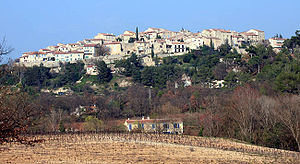Grambois
| Grambois | ||
|---|---|---|

|
|
|
| region | Provence-Alpes-Cote d'Azur | |
| Department | Vaucluse | |
| Arrondissement | Apt | |
| Canton | Pertuis | |
| Community association | Territorial South Luberon | |
| Coordinates | 43 ° 46 ' N , 5 ° 35' E | |
| height | 278-628 m | |
| surface | 31.46 km 2 | |
| Residents | 1,251 (January 1, 2017) | |
| Population density | 40 inhabitants / km 2 | |
| Post Code | 84240 | |
| INSEE code | 84052 | |
| Website | http://www.grambois.fr | |
 View of Grambois |
||
Grambois is a French commune with 1,251 inhabitants (at January 1, 2017) in the Vaucluse department in the region of Provence-Alpes-Cote d'Azur . It belongs to the canton of Pertuis in the Apt arrondissement .
geography
Grambois is located in the southeast of the Vaucluse department, about 10 kilometers northeast of the city of Pertuis . Neighboring municipalities are Saint-Martin-de-la-Brasque in the west, La Tour-d'Aigues in the southwest, Mirabeau in the south, Beaumont-de-Pertuis in the east, as well as La Bastide-des-Jourdans , Vitrolles-en-Lubéron and Peypin -d'Aigues to the north.
In the north of the municipality, the mountains of the Grand Luberon rise with the Luberon Regional Park , to which the municipality belongs. The 24-kilometer-long Èze flows right through the municipality and past Grambois , which flows into the Durance at Pertuis as a right tributary .
traffic
The most important road through the municipality is the départementale D956, which leads from Pertuis to Manosque in the Alpes-de-Haute-Provence department .
Parish partnership
Grambois has a partnership with the Italian municipality of Solignano in Emilia-Romagna .
history
The existence of Grambois has only been documented since the 11th century, although traces of settlement go back to the Neolithic and the location of three Gallo-Roman villas has been proven.
In the 12th century Grambois was annexed to the county of Forcalquier and in the 13th century it became the property of the Counts of Provence . The place was in a strategic position and was surrounded by a strong fortification wall in the 13th century, which was expanded a century later. At that time Grambois was one of the twelve Forteresses de Provence ("Fortresses of Provence ").
In 1590, during the French Wars of Religion , to Grambois proved a loyal ally of Henry IV. , Leading to the siege of the troops of Savoy Duke I. Charles Emmanuel led. After ten days of fighting, the village had to surrender. It was looted and burned down and was forgotten for some time.
Of the great noble families who ruled in Grambois since the 15th century (Forcalquier-Viens, de La Croix de Gautier), especially the house Roque Ante is remembered, the 17th of the late century to the French Revolution in Mr. Castle lived. Its probably most famous member Pierre de Roquesante (1619-1707) played an important role in the trial of Nicolas Fouquet , who was accused of embezzling public funds as royal finance minister.
In the 19th century there was some textile industry ( spinning mills ), but the place lived more from growing fruit and vegetables and especially from growing grapes . In 1924 a wine cooperative was founded and handicrafts and tourism developed . After Grambois suffered from constant rural exodus, the population began to rise again in the 1950s. In 1990 the village was used as a filming location for the film The Glory of My Father of Marcel Pagnol's childhood memories Souvenirs d'enfance .
Population development
| year | 1962 | 1968 | 1975 | 1982 | 1990 | 1999 | 2006 | 2016 |
|---|---|---|---|---|---|---|---|---|
| Residents | 452 | 465 | 548 | 709 | 903 | 1113 | 1155 | 1264 |
Attractions
The village of Grambois is a typical Provence, walled village Perché . From the eastern city walls remnants have been preserved from the 14th century, including a long, with loopholes perforated wall that was reinforced by two rectangular towers. One of the two towers, called Tourrache , is a barbican that served as a consular house in the 17th and 18th centuries .
The large mansion Château de Grambois is located within the wall on the town hall square. It was built in the late 16th century on the site of the old rectory . The newly designed facade dates back to 1730. Madame de Sévigné , her daughter Madame de Grignan and the Count of Mirabeau lived in the castle for a time .
The earliest mention of the Romanesque parish church of Notre-Dame-de-Beauvoir goes back to 1096. It was expanded over time, but the roof collapsed in 1708 due to an earthquake . During this time, the upper part, the current facade and the bell tower were rebuilt. The wrought-iron campanile was erected in the 19th century .
The hermitage of St-Pancrace is a chapel that was enlarged in the 17th century. A private cemetery was built by the owner at the time in the 19th century and a restoration was carried out. Around 1912, the three painters Georges Dufrénoy , Émile Lombard and Pierre Girieud , the latter a fresco painter from the Marseille school , created religiously inspired pictures on the walls of the chapel vestibule . They wanted to reintroduce the fresco technique on fresh mortar, following the example of the Italian Renaissance .
coat of arms
|
The coat of arms of Grambois is emblazoned as follows :
It is a talking coat of arms of the second degree, i. that is, it indirectly indicates the name of the owner. The tree refers to the name Grand Bois (German: "Great Forest"), which was registered in 1696 in the General Book of Arms of France together with this coat of arms. In 1866 it reappeared in the Provence register of arms and was finally declared the municipality's official coat of arms in 1996. |
|
|
A second coat of arms was in use for a long time:
The origin of the palm coat of arms is unknown, but it can be proven on many official documents, for example on plague letters from 1720. Although it was officially replaced by the fir coat of arms in 1866, both forms of coat of arms coexisted for a long time. It was still used by the historian André-Marius Garcin at the end of the 19th century. |
literature
- Michel Albarède u. a .: Vaucluse (= Encyclopédies du Voyage ). Gallimard Loisirs, Paris 2007, ISBN 2-7424-1900-4 , p. 293-294 .
- Cony Ziegler: Provence with Camargue . 2nd updated edition. Reiseuchverlag Iwanowski, Dormagen 2009, ISBN 978-3-933041-54-8 , p. 336-337 .
- Marie-Christine Mansuy u. a .: Parc Naturel Régional du Luberon (= Encyclopédies du Voyage ). Gallimard Loisirs, Paris 2010, ISBN 978-2-7424-2737-6 , pp. 133 .
Web links
- Official website (French)
- Grambois at paysdaigues.fr (French)
Individual evidence
- ↑ The community on annuaire-mairie.fr
- ↑ a b c d e Grambois - Histoire. (No longer available online.) Official website of the Tourist Office, archived from the original on March 4, 2016 ; Retrieved October 27, 2012 (French). Info: The archive link was inserted automatically and has not yet been checked. Please check the original and archive link according to the instructions and then remove this notice.
- ^ Cony Ziegler: Provence with Camargue. 2009, p. 336.
- ↑ a b Michel Albarède u. a .: Vaucluse. 2007, p. 293.
- ↑ a b c Grambois - Le village. (No longer available online.) Paysdaigues.fr, archived from the original on December 7, 2014 ; Retrieved October 28, 2012 (French). Info: The archive link was inserted automatically and has not yet been checked. Please check the original and archive link according to the instructions and then remove this notice.
- ^ Marie-Christine Mansuy et al. a .: Parc Naturel Régional du Luberon. 2010, p. 133.
- ^ A b Deux Blasons pour un Village. (No longer available online.) Official website of the Tourist Office, archived from the original on January 5, 2016 ; Retrieved October 28, 2012 (French). Info: The archive link was inserted automatically and has not yet been checked. Please check the original and archive link according to the instructions and then remove this notice.





